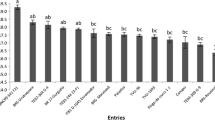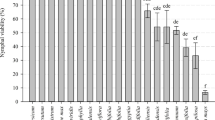Abstract
Silverleaf whitefly (Bemisia tabaci biotype B) has caused significant damage, year after year, and can be considered one of the major pests responsible for the increase in use of insecticides in cotton. This research aimed to evaluate the biology and preference for oviposition and feeding of Bemisia tabaci biotype B in wild cotton genotypes. The experiments were conducted at the Experimental Farm of the Mato Grosso do Sul State University, Cassilândia-MS, from March 24th to May 13th, 2017. The treatments were composed of the following genotypes:, APGO 01 and APGO 02 (Gossypium barbadense),TEX 1116 and TEX 1964 (G. hirsutum) and G. arboreum acquired in EMBRAPA germplasm, BRS 269 (standard cultivar/control) widely grown in Brazil. The infestations were carried out on plants 25 days after emergence in a no-choice test and at 42 days for the free-choice test, the cages they were infested with 100 whitefly adults per plant. The number of eggs per leaf, the density of trichomes, the viability of nymphs and the duration of the juvenile phases, in days, on the youngest leaf in the upper third of the plant were evaluated. The averages for cotton genotypes were grouped by the Scott Knott test at the 5% probability level. Low preference for oviposition of B. tabaci biotype B on genotypes APGO 01 and APGO 02 was observed in the no-choice test. The genotypes APGO 01, APGO 02, and BRS 269 were the least preferred for oviposition and had the lowest density of trichomes at 43 days after emergence in 24 hours after infestation. It was verified that in the genotypes APGO 01 and APGO 02, there was an increase in the density of trichomes, and consequently, there was an increase in the number of eggs per cm² in 48 hours after infestation. After 72 hours of infestation, a positive and significant correlation (r = 0687**) was observed between the number of eggs per cm² and the density of trichomes. A positive correlation was observed between the density of trichomes and the preference of oviposition. A negative effect of glandular trichomes and preference for oviposition was observed for APGO 02.. Resistance by antibiosis and / or non-preference for feeding in the genotypes APGO 01, APGO 02 and G. arboreum were observed for prolonging the development of the insect in the juvenile/nymph phase.






Similar content being viewed by others
References
Ahmad AHM, Elhag EA, Bashir NHH (1987) Insecticide resistance in the cotton whitefly (Bemisia tabaci Genn.) in the Sudan Gezira. Trop Pest Manag 33:67–72. https://doi.org/10.1080/09670878709371118
Ahmad M, Arif MI, Ahmad Z, Denholm I (2002) Cotton whitefly (Bemisia tabaci) resistance to organophosphate and pyrethroid insecticides in Pakistan. Pest Manag Sci 8:203–208. https://doi.org/10.1002/ps.440
Andrade MC, Silva AA, Neiva IP, Oliveira IRC, Castro EM, Francis DM, Maluf WR (2017) Inheritance of type IV glandular trichome density and its association with whitefly resistance from Solanum galapagense accession LA1401. Euphytica 213:52. https://doi.org/10.1007/s10681-016-1792-1
Araujo LHA, Bleicher E, Sousa S L, Queiroz JC (2000) Manejo da mosca-branca Bemisia argentifolii Bellows & Perring no algodoeiro. EMBRAPA-CNPA, Campina Grande, 34. (Circular Técnica, 40)
Bethke JA, Paine TD, Nuessly GS (1991) Comparative biology, morphometrics and development of two populations of Bemisia tabaci (Homoptera: Aleyrodidae) on cotton and poinsettia. Ann Entomol Soc Am 84:407–411. https://doi.org/10.1093/aesa/84.4.407
Boiça Junior AL, Campos ZR, Lourenção AL, Campos AR (2007) Adult attractiveness and oviposition preference of Bemisia tabaci (Genn.) (Homoptera: Aleyrodidae) B-biotypes in cotton genotypes. Sci Agric Piracicaba 64:147–151. https://doi.org/10.1590/S0103-90162007000200007
Cahill M, Byene FJ, Gorman KJ, Denholm I, Devoshire AL (1995) Pyrethroid and organophosphate resistance in the tobacco whitefly Bemisia tabaci (Homoptera: Aleyrodidae). Bull Entomol Res 8:181–187. https://doi.org/10.1017/S0007485300034258
Campos ZR, Boiça Junior AL, Lourenção AL, Campos AR (2005) Fatores que afetam a oviposição de Bemisia tabaci (Genn.) biótipo B (Hemiptera: Aleyrodidae) na cultura algodoeira. Neotrop Entomol Londrina 34:823–827. https://doi.org/10.1590/S1519-566X2005000500015
Campos ZR, Boiça Junior AL, Lourenção AL, Campos AR (2009) Parâmetros biológicos de Bemisia tabaci (Genn.) biótipo B (Hemiptera: Aleyrodidae) em genótipos de algodoeiro. Bragantia Campinas 68:1003–1007. https://doi.org/10.1590/S0006-87052009000400021
Dângelo RAC, Michereff Filho M, Campos MR, Silva PS, Guedes RNC (2018) Insecticide resistance and control failure likelihood of the whitefly Bemisia tabaci (MEAM1; B biotype): a Neotropical scenario. Ann Appl Biol 172:88–99. https://doi.org/10.1111/aab.12404
Dennehy TJ, Degain BA, Harpold VS, Brown JK, Morin S, Fabrick JA, NicholszRL, (2005) New challenges to management of whitefly resistance to insecticides in Arizona. Cooperative Extension, The University of Arizona, Tucson, 32p
Fenemore PG (1980) Oviposition of potato tuber moth, Phthorimaea operculella Zell. (Lepidoptera: Gelechiidae); identification of host-plant factors influencing oviposition response. N Z J Zool 7:435–439. https://doi.org/10.1080/03014223.1980.10423798
Hasanuzzaman ATM, Islam MN, Zhang Y, Zhang CY, Liu TX (2016) Leaf morphological characters can be a factor for intra-varietal preference of whitefly Bemisia tabaci (Hemiptera: Aleyrodidae) among eggplant varieties. PLoS One 11:e0153880. https://doi.org/10.1371/journal.pone.0153880
Heinz KM, Zalom F (1995) Variation in trichome based resistance to Bemisia argentifolii (Homoptera: Aleyrodidae) oviposition on tomato. J Econ Entomol Coll Park Lanham 88:1494–1502. https://doi.org/10.1093/jee/88.5.1494
Jindal V, Dhaliwal GS (2011) Mechanisms of resistance in cotton to whitefly (Bemisia tabaci): antixenosis. Phytoparasitica 39:129–136. https://doi.org/10.1007/s12600-011-0144-x
Lara FM (1991) Princípios de resistência de plantas a insetos.1.ed. Ícone Editora, São Paulo, 336p
Lenteren JCV, Noldus PJJ. (1990) Whitefly-plant relationships: behavioral and ecological aspects. In: Gerling D. Whiteflies: their bionomics, pest status and management. Wimborne: Intercept, p. 47–89.
McAuslane HJ (1996) Influence of leaf pubescence on ovipositional preference of Bemisia argentifolii (Homoptera: Aleyrodidade) on soybean. Environ Entomol Lanham 25:834–841
Miranda JE, Rodrigues SMM (2015) História do bicudo no Brasil. In: Belot, J.L. (Org.). O bicudo-do-algodoeiro (Anthonomus grandis BOH., 1843) nos cerrados brasileiros: Biologia e medidas de controle (pp. 11–45). 1st Ed. Instituto Mato-grossense do Algodão - IMAmt, Cuiabá, 2
Miyazaki J, StillerWN, Wilson LJ (2013) Identification of host plant resistance to silverleaf whitefly in cotton: Implication for breeding. Field Crops Res Narrabri 154:145–156. https://doi.org/10.1016/j.fcr.2013.08.001
Mound LA (1965) Effect of leaf hairs on cotton whitefly population in the Sudan Gezira. Emp Cotton Growing Rev 42:33–40
Naveen N, Chaubey R, Kumar D, Rebijith KB, Rajagopal RB, Subrahmanyam B, Subramanian S (2017) Insecticide resistance status in the whitefly, Bemisia tabaci genetic groups Asia-I, Asia-II-1 and Asia-II-7 on the Indian subcontinent. Sci Rep 7:40634. https://doi.org/10.1038/srep40634
Neiva IP, Andrade Júnior VC, Maluf WR, Oliveira CM, Maciel GM (2013) Role of allelochemicals and trichome density in the resistance of tomato to whitefly. Ciênc Agrotecnol 37:61–67. https://doi.org/10.1590/S1413-70542013000100007
Normam JR, Riley JW, Stansly DG, Ellsworth PA, Toscano PC, NC (1996) Management of Silverleaf Whitefly: a comprehensive manual on the biology, economic impact and control tactics. USDA, Washington, 22p
Oliveira CES, Carneiro DEF, Toscano LC, Santos RMF (2018) Dinâmica populacional de Bemisia tabaci biótipo B (Gennadius, 1889) em cultivares de soja transgênica. Rev Agric Neotrop 5:1–5. https://doi.org/10.32404/rean.v5i2.1425
Omer AD, Tabashnik BE, Johnson MW, Costa HS, Ullman DE (1993) Genetic and environmental influences on susceptibility to acephate in sweet potato whitefly (Homoptera: Aleyrodidae). J Econ Entomol 8:652–659. https://doi.org/10.1093/jee/86.3.652
Oriani MAG, Lara FM (2000) Oviposition preference of Bemisia tabaci (Genn.) Biotype B (Homoptera: Aleyrodidae) for bean genotypes containing arcelin in the seeds. An Soc Entomol Brasil 29:565–572. https://doi.org/10.1590/S0301-80592000000300019
Ozgur AF, Sckeroglu E (1986) Population development of Bemisia tabaci (Homoptera: Aleyrodidae) on various cotton varieties in Cukurova, Turkey. Agric Ecosyst Environ 17:83–88
Painter RH (1968) Insect resistance in crop plants. MacMillan, New York, 520p
Peña EA, Pantoja A, Beaver J (1992) Determinación de la pubescencia de cuatro genotipos de habichuela, Phaseolus vulgaris L. J Agric Univ P R 76:71–82
Peña EA, Pantoja A, Beaver J, Armstrong A (1993) Oviposición de Bemisia tabaci Genn. (Homoptera: Aleyrodidae) en cuatro genotipos de Phaseolus vulgaris L. (Leguminosae) con diferentes grados de pubescencia. Folia Entomologica Mexicana, México 87:1–12
Perry AS (1985) The relative susceptibility to several insecticides of adult whiteflies (Bemisia tabaci) from various cotton-growing areas in Israel. Phytoparasitica 13:77–78
Pollard DG, Saunders JH (1956) Relations of some cotton pests to jassid resistant sakel, 33. Empire Cotton Growing Review, London, pp 197–202
Prado JC, Peñaflor MFGV, Cia E, Vieira SS, Silva KI, Carlini-Garcia LA, Lourenção AL. (2016) Resistance of cotton genotypes with different leaf colour and trichome density to Bemisia tabaci biotype B. J Appl Entomol 140 (6):405–413. https://doi.org/10.1111/jen.12274
Santos WJ (2001) Identificação, biologia, amostragem e controle das pragas do algodoeiro. In EMBRAPA Agropecuária Oeste & EMBRAPA Algodão. Algodão: Tecnologia de produção. Dourados, EMBRAPA Agropecuária Oeste, 296p, p 181–226
Santos HG, Jacomine PKT, Anjos LHC, Oliveira VA, Oliveira JB, Coelho MR, Lumbreras JF, Cunha TJF (2013) Sistema Brasileiro de classificação de solos (353p). 3rd ED. EMBRAPA, Rio de Janeiro-RJ
Satar G, Ulusoy MR, Nauen R, Dong K (2018) Neonicotinoid insecticide resistance among populations of Bemisia tabaci in the Mediterranean region of Turkey. Bull Insectol 71:171–177
Stansly PA, Naranjo SE (2010) (eds). Bemisia: Bionomics and Management of a Global Pest. Springer, New York, 540p
Tomquelski GV, Marques E (2015) Manejo de pragas em algodoeiro. Pesquisa, Tecnologia e Produtividade, v. 1, p. 17–49
Torres LC, Souza B, Amaral BB, Tanque RL (2007) Biologia e Não-preferência para oviposição por Bemisia tabaci (Gennadius) Biótipo B (Hemiptera: Aleyrodidae) em cultivares de Algodoeiro. Neotrop Entomol Londrina 36:445–453
Toscano LC, Santos TM, Boica Junior AL (2003) Preferência de Bemisia tabaci biótipo B para oviposição em cultivares de algodoeiro. Pesqui Agrop Brasileira 38:155–160. https://doi.org/10.1590/S0100-204X2003000100020
United States Department of Agriculture (USDA) (2014) Keys to soil taxonomy, 12th edn. USDA-Natural Resources Conservation Service, Washington, DC
Vendramim JD, Souza AP, Ongarelli MG (2009) Comportamento de Oviposição da Mosca-Branca Bemisia tabaci (Genn.) (Hemiptera: Aleyrodidae) Biótipo B em Tomateiro. Neotrop Entomol 38:126–132. https://doi.org/10.1590/S1519-566X2009000100014
Vieira SS, Bueno AF, Boff MIC, Bueno RCOF, Hoffman-Campo CB (2011) Resistance of soybean genotypes to Bemisia tabaci (Genn.) biotype B (Hemiptera: Aleyrodidae). Neotrop Entomol Londrina 40:117–122. https://doi.org/10.1590/S1519-566X2011000100018
Walker GP, Natwick ET (2006) Resistance to silverleaf whitefly, Bemisia argentifolii (Hem., Aleryrodidae), in Gossypium thurberi, a wild cotton species. J Appl Entomol Oxford 130:429–436. https://doi.org/10.1111/j.1439-0418.2006.01083.x
Yao F, Zhen Y, Huang X, Ding XL, Zhao JW, Desneux N, He YX, Weng QY (2017) Dynamics of Bemisia tabaci biotypes and insecticide resistance in Fujian province in China during 2005–2014. Sci Rep 7:40803. https://doi.org/10.1038/srep40803
Acknowledgements
“Mention of trade names or commercial products in this publication is solely for the purpose of providing specific information and does not imply recommendation or endorsement by the U.S. Department of Agriculture. The USDA is an equal opportunity provider and employer”.
The authors wish to thank researcher Juliano Gomes Pádua, curator gene bank EMBRAPA (Brasília - DF), for partnership with State University of Mato Grosso do Sul, Crop Science Department for Cassilândia. We are grateful for the seeds provided by “Embrapa Genetic Resources and Biotechnology” for the seeds of Gossypium arboreum, Tex 1116 and Tex 1964.
Author information
Authors and Affiliations
Contributions
CESO, LVH, LCT and TWW conceived research. CESO, MSQ and TZ conducted experiments. LVH, LCT and TZ contributed material. CESO, MSQ and TZ analysed data and conducted statistical analyses. CESO and TWW wrote the manuscript. CESO, LVH, TZ and TWW secured funding. All authors read and approved the manuscript.
Corresponding author
Ethics declarations
Competing interests
The authors declare no competing financial interests.
Rights and permissions
About this article
Cite this article
da Silva Oliveira, C.E., Hoffmann, L.V., Toscano, L.C. et al. Resistance of cotton genotypes to silverleaf whitefly (Bemisia tabaci [GENNADIUS] Biotype B). Int J Trop Insect Sci 41, 1697–1707 (2021). https://doi.org/10.1007/s42690-020-00373-8
Received:
Accepted:
Published:
Issue Date:
DOI: https://doi.org/10.1007/s42690-020-00373-8




